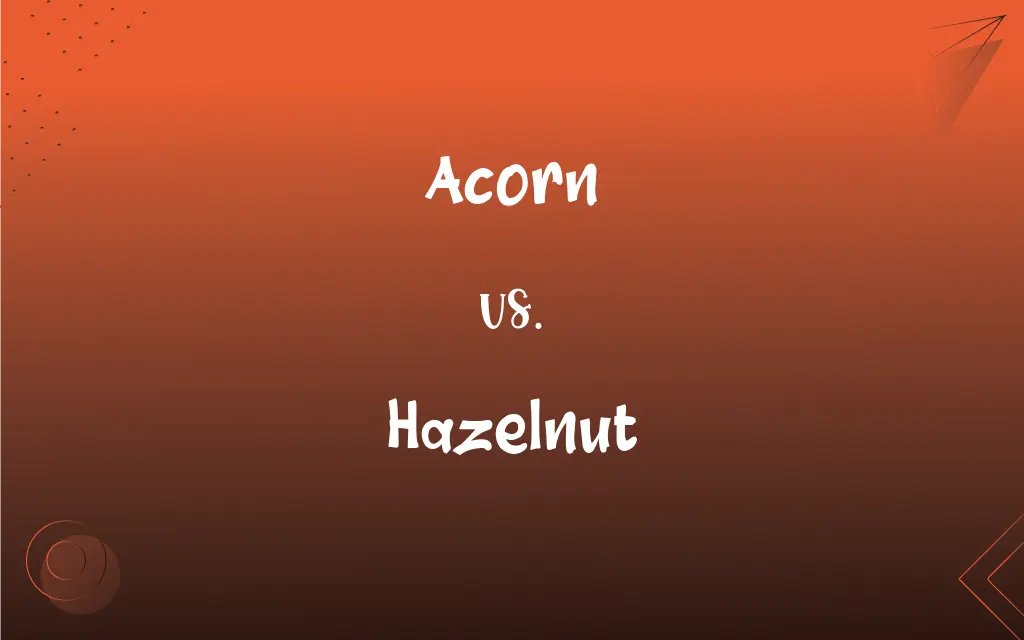Acorn vs. Hazelnut: What's the Difference?
Edited by Aimie Carlson || By Harlon Moss || Updated on February 5, 2024
Acorn is the nut of oak trees, symbolic of potential; hazelnut is from hazel trees, valued for flavor and nutrition.

Key Differences
Acorns, the fruit of oak trees, are hard, rounded nuts encased in a tough shell with a distinctive cap, symbolizing strength and potential in various cultures. Hazelnuts, on the other hand, are the fruit of the hazel tree, smaller and encased in a smooth shell without a cap, celebrated for their rich flavor and nutritional value, often used in confections and cooking.
The acorn plays a significant role in forest ecosystems, serving as a crucial food source for wildlife, while also being associated with endurance and growth in folklore. The hazelnut is similarly valued in culinary and cultural contexts, noted for its contribution to sweets and savory dishes alike, and sometimes linked to wisdom and protection in mythology.
Acorns vary greatly in size and shape depending on the species of oak tree, with some acorns being elongated and others more rounded. This contrasts with hazelnuts, which tend to have a more uniform, spherical or oval shape, making them easily recognizable and favored for uniformity in culinary applications.
The germination process of an acorn, which involves the nut embedding itself in the ground to grow into a mighty oak tree, is a slow and steady transformation, symbolizing patience and resilience. Hazelnuts, however, germinate more readily, quickly sprouting into bushes that bear fruit in a few years, reflecting a theme of rapid growth and fertility.
Both acorns and hazelnuts serve as important food sources for wildlife and have been used by humans throughout history, acorns require processing to remove tannins and make them edible for human consumption. Hazelnuts are edible raw or roasted, highlighting their accessibility and immediate appeal as a food source.
ADVERTISEMENT
Comparison Chart
Origin Tree
Oak tree
Hazel tree
Shape
Typically more elongated with a cap
Generally round or oval, no cap
Use in Folklore/Culture
Symbolizes potential and endurance
Associated with wisdom and fertility
Culinary Use
Requires processing due to tannins
Edible raw or roasted, widely used in cooking
Germination
Slow, grows into a large tree
Quick, grows into a bush
ADVERTISEMENT
Wildlife Importance
Crucial food source, especially for larger mammals
Important for smaller animals, birds
Nutritional Value
High in fats, but less commonly eaten by humans
High in fats, vitamins, and minerals, popular in human diet
Cultural Significance
Often associated with strength and resilience
Linked to abundance and protection
Acorn and Hazelnut Definitions
Acorn
A nut from an oak tree, symbolizing growth and potential.
The forest floor was littered with acorns, a sign of the oak trees' abundance.
Hazelnut
A sweet-flavored nut from the hazel tree, used in various dishes.
Hazelnut spread has become a breakfast favorite worldwide.
Acorn
The seed of the oak, encased in a hard shell.
She collected acorns during her walk to study their various shapes and sizes.
Hazelnut
The fruit of the hazel, often roasted to enhance its flavor.
Roasted hazelnuts add a crunchy texture to salads.
Acorn
A source of food for wildlife, especially squirrels and birds.
The squirrel busily gathered acorns for its winter stash.
Hazelnut
Cultivated for its nutritional value and flavor.
The hazelnut harvest promised a good yield for the farmers this year.
Acorn
An emblem of endurance and strength in folklore.
The acorn, though small, symbolizes the strength of nature.
Hazelnut
A key ingredient in confections and chocolate products.
The chocolate bar was filled with whole hazelnuts.
Acorn
A metaphor for something small with great potential.
From a tiny acorn, a mighty oak tree grows.
Hazelnut
Symbolic of wisdom and protection in ancient lore.
Hazelnuts were once carried as talismans for protection.
Acorn
The fruit of an oak, consisting of a single-seeded, thick-walled nut set in a woody, cuplike base.
Hazelnut
The edible nut of a hazel, having a hard smooth brown shell. Also called filbert.
Hazelnut
See hazel.
Hazelnut
The fruit of the hazel tree.
Hazelnut
The nut of the hazel.
Hazelnut
Any of several shrubs or small trees of the genus Corylus bearing edible nuts enclosed in a leafy husk
Hazelnut
Nut of any of several trees of the genus Corylus
FAQs
Can you eat acorns raw?
No, acorns contain tannins and must be processed to make them edible.
What tree does a hazelnut come from?
Hazelnuts come from the hazel tree.
What is an acorn?
An acorn is the nut of an oak tree, typically encased in a tough shell.
Are hazelnuts good for you?
Yes, hazelnuts are rich in vitamins, minerals, and healthy fats.
Do all oak trees produce acorns?
Yes, all oak species produce acorns, but the size and shape can vary.
What's the best way to store hazelnuts?
Store them in a cool, dry place or refrigerate to extend freshness.
Why are acorns important to wildlife?
They serve as a vital food source for many animals, especially in fall and winter.
What distinguishes hazelnuts from other nuts?
Their sweet flavor and the fact they're often used in confections set them apart.
How are hazelnuts used in cooking?
Hazelnuts are used in a variety of dishes, from desserts to savory recipes.
How do you make acorns edible?
By leaching them in water to remove tannins, then roasting or boiling.
Are acorns used in any traditional dishes?
Acorns have been used in traditional dishes by indigenous cultures, mainly as flour.
Are hazelnuts used in any traditional medicine?
Yes, they've been used in folk remedies for their nutritional properties.
What health benefits do hazelnuts offer?
They're beneficial for heart health, rich in antioxidants, and help reduce cholesterol levels.
What's the environmental impact of growing hazelnuts?
Hazelnut cultivation can have a positive environmental impact when managed sustainably, supporting biodiversity.
Do animals eat hazelnuts?
Yes, many small mammals and birds eat hazelnuts.
What cultural significance do acorns hold?
They symbolize potential and strength in various traditions.
How long do hazelnuts last?
Properly stored, hazelnuts can last up to a year.
Can acorns grow into oak trees?
Yes, with proper conditions, an acorn can germinate and grow into an oak tree.
Is it common to find acorns year-round?
Acorns are typically found in the fall, though availability can depend on the oak species.
How do acorns affect soil?
Falling acorns can contribute to soil health by adding organic matter.
About Author
Written by
Harlon MossHarlon is a seasoned quality moderator and accomplished content writer for Difference Wiki. An alumnus of the prestigious University of California, he earned his degree in Computer Science. Leveraging his academic background, Harlon brings a meticulous and informed perspective to his work, ensuring content accuracy and excellence.
Edited by
Aimie CarlsonAimie Carlson, holding a master's degree in English literature, is a fervent English language enthusiast. She lends her writing talents to Difference Wiki, a prominent website that specializes in comparisons, offering readers insightful analyses that both captivate and inform.































































